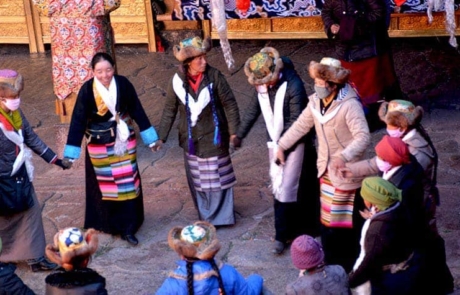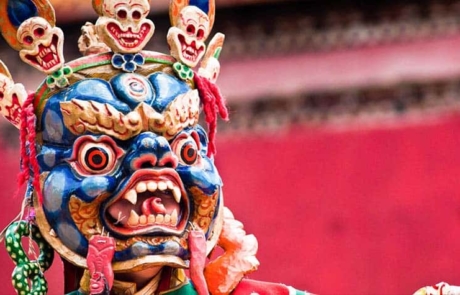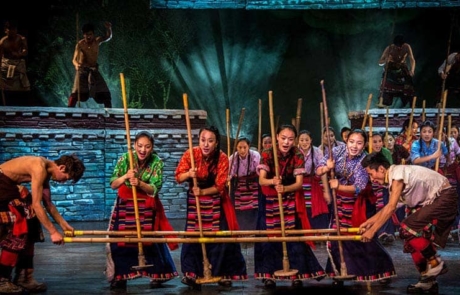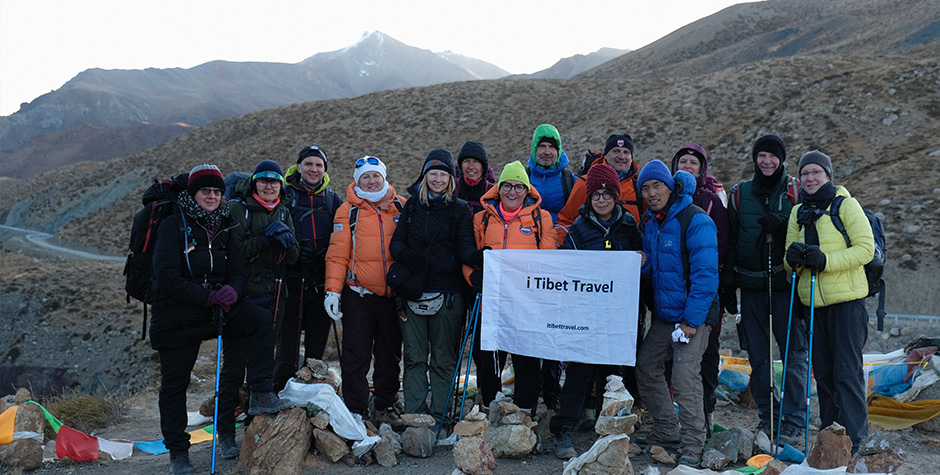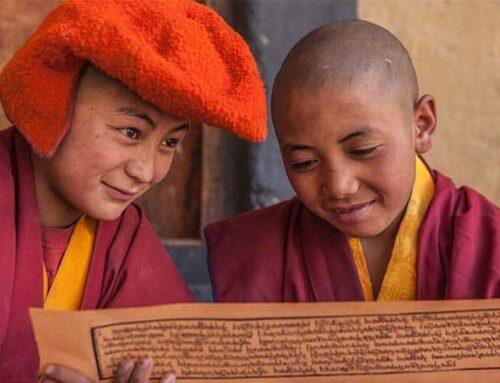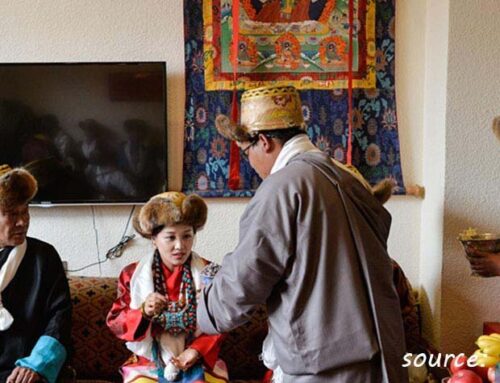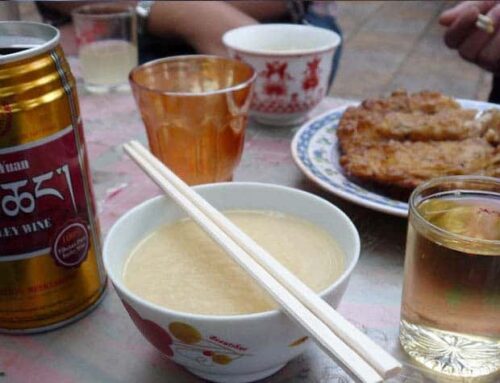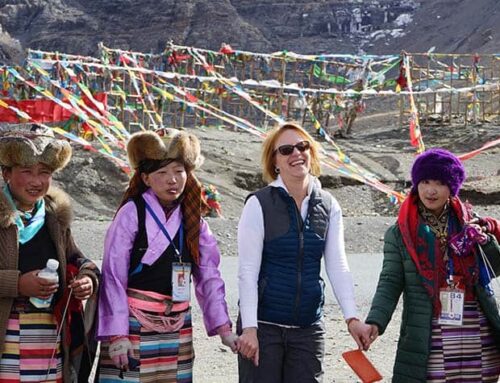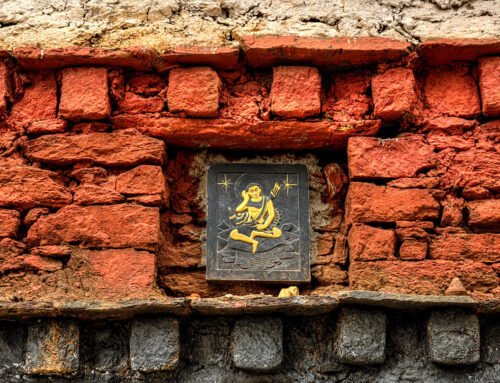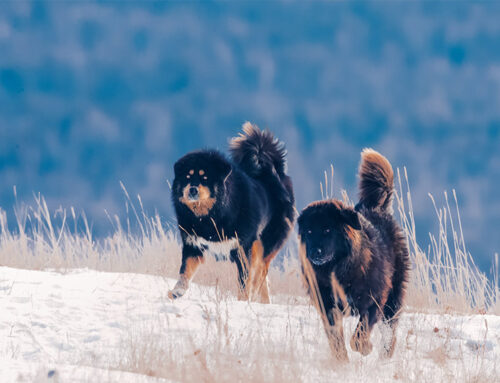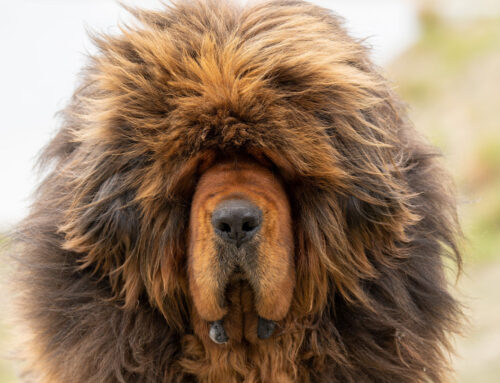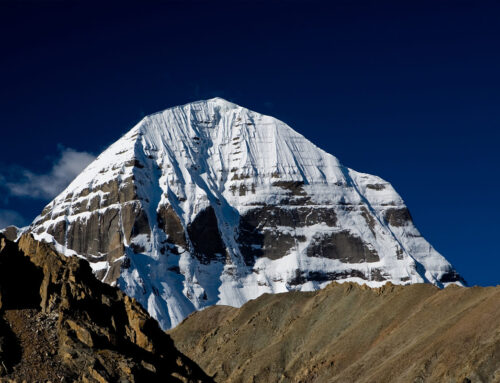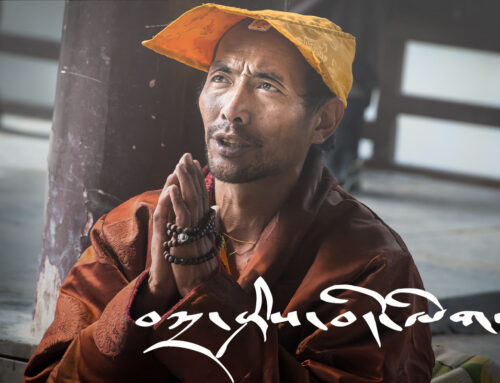Tibetan Song and dance are other important topics about Tibetan Culture and way of life we would like to discuss in this website. Many consider Tibet as the ocean of Songs and Dance, besides the popular notion of Tibet being an ocean of spirituality and wisdom. Since childhood, all the children are introduced to songs and dances. Tibetan song and dance are used as a medium to introduce the Buddhist philosophy to young ones and teach them of the reality to human existence and Norms.
We have dances and songs for all occasions. Different categories of Tibetan songs and dance are; Wedding, Love, Archery, social Gathering, folk, Drinking, Labor and we even have Tibetan song and dance to introduce the Buddhist teaching and life story of the enlightened being. Songs and Dances are deeply connected to our life in Tibet.
On the vast open area of Tibetan plateau, Lonely nomads catering herd of their animals would be accompanied by their songs and to express their feelings.
Travel to Tibet, the first thing you will notice is a people playing songs in the street. which would be your first experience in Tibet. Everywhere you will go you will constantly hear some music. In the spiritual places, you will hear chants and in the marketplace, you will constantly hear songs. We love songs and dance. We have a song and dance for every occasion. During your visit to Tibet, we will be often invited by your Tibet travel agency in Lhasa for the dinner with the song and dance performance.
Different types of Tibetan Song and Dance
Dances in Tibet is of different in the different region and different occasion. Each region of Tibet has a different way in their folk dance. Majority of the traditional Tibetan song and dance is always the association with some big social and religious occasions like the birth of a high lama, the enthronement of high lamas and spiritual dance or meditative dance. We also have danced for the different celebration of personal life, including the dance for marriage, dance for the birth of a child, dance for house building and Festivals. Following are some of the very important dance form.
Tibetan Cham dance is often performed in the monasteries during the holy festival. The majority of the Cham dance is performed during the holy month of Saga Dawa. The most popular of all the cham dance is that of the Tsurphu monastery, Drigung Monastery, and Sakya monastery.
Cham is the meditative dance, The monks will wear the mask and custom associated with the dance. The performance of cham dance is often associated with the Tibetan traditional instrument. We believe this dance brings great merit for all those who perceive it, because of dance associated with the instruction to compassion and other basic Buddhist principle. Cham dance as often depictions on the incidences from the like of Guru Padmasambhava and Other Saints.
Tibetan Drum Dance
Tibetan drum dance and it is a very popular and very energetic Tibetan dance. Tibetan Drum Dance is of two kinds: one is called Dro dance, which is originated from the Shanan prefecture of Tibet. Other is called Relpa, it is from the Kham region ethnic Tibetan area in Sichuan.
Dro dance is originated from Lhokha Prefecture of Tibet. In this performance, the dance is lead by a head man wearing white Mask signifying of an old man. This mask is a similar design to that of the Mask of Tang Tong Gyalpo, which is used in Tashi Sholpa dance. Rest of the group members will have a small drum underneath their arm and they will beat it while dancing. This dance requires great flexibility and it will require many months of training to perfect it.
Relpa dance which originates from Kham area. Is dance by women hold the drum in their hand and Men carrying small bell in their hand. Like Dro Dance, artist in Relpa dance requires great athletic skill in turning and twisting their bodies. Initially, when the dance starts all the ladies will perform and after a little bit, men will join the dance. It is a great dance to watch with all these moves and stunt.
Tashi Sholpa
Tashi Sholpa is first performed during the enthronement of fifth Dalia Lama by the Shol Lhamo Troupe of Tibetan Opera in Drepung monastery. All the performers will be wearing the white Tibetan mask representing the Thangtong Gyalpo. The Saint lived for 140 years of Ages, which is why wearing his mask during the important occasions are considered very auspicious.
It is often the first dance during all the major cultural events in Tibet.
Tibetan Folk Dance
Besides the above iconic Tibetan dance, we also have lots of dance from the different regions of Tibet. We have danced for all the major events in Life include the Arka Dance which is the dance workers will perform during the work of the rooftop during the construction. In the east Tibet, we also have a dance for wall beating.
All the local folk dances show the great diversification of Tibetan culture in the plateau. It is also a great representative of all the different kinds of cloths we have in Tibet. Traditionally Tibetan people love to drink and dance. Which is why we have rich collections of Tibetan Song and dance.
Nangma Toeshe
Nangma ནང་མ་ is a genre of traditional Tibetan song and Dance music. The word Nangma derives from the Persian word Naghma meaning melody. This genre of Tibetan song is very popular in Lhasa and it is often called the Lhasa song. Historically this song was brought to Tibet from Kashmir by the Muslim trader, who later settled in Lhasa and Become the community of Lhasa Muslim.
Now a day we use the name as the common name for all the traditional Tibetan nightclubs in Tibet.
Lama Mani
Lama Mani is the common name for the Buddhist monks’ wanderer, how would travel far and wide to narrate the stories (in song forms) of legendary Buddhist master and their teaching. They are also called Bhuchen. It is the Tibetan invention of the Buddhist culture in Tibet. Lama Mani will preach the Dharma with the aid of scroll Thangka paintings. Majority of Tibetan in the old days are illiterate and Lama mani narratives were attractive to the mass. Lama Mani would us a very common and Understandable language, and teaching are often the combination of earthy reality and Often with jokes. Unlike the formal lama, Lama Mani would mix up with the mass to reduce the gaps between them.
Buddhist Music
Unlike Traditional Buddhist in India. Tibetan Buddhism rituals are often associated with ritual music. These ritual music are an adaptation to the local Tibetan pre-Buddhist culture of Bön. Ritual music is usually pipe, drum, and cymbal. During the ritual ceremony between monks would often play music.
Chanting in Buddhism is in all the Major traditional sects of Buddhism. It is a means of preparing the mind for Meditation. Some also use chanting for ritual purpose.
Tibetan Monks are well known for their skill in throat singing. it is a specialized way to chanting in which, chanter produce multiple distinct pitches simultaneously by amplifying the voice. The Chant of Om Mani Padme Hum (The Mantra of Avalokitesvara), the chant of Tara Prayer, Bhaisajyaguru (Medicine Buddha) and Amitābha (Buddha of Infinite Light) are very popular.
Milarepa Song (Tibetan Songs of realization)
The Tibetan Buddhist songs of realization are very popular in the old days. When a master is coveying his understanding of the realization to the student and when the student reporting they realization to their master, it is very often expressed in the form of song. Milarepa is one such great master using this way.
Milarepa is great Yogic and the only person in the history of Buddhism to achieve enlightenment in one lifetime. The book of hundred thousand songs of Milarepa is a source of instruction and inspiration for Tibetan Buddhist, especially with the Kagyu school of Tibetan Buddhism.
Ling Gesar Song
Ling Gesar is a legendary warrior king. He is said to have personally blessed by Guru Rinpoche. The story of Ling is mythical and it considers are the same as the Ramayan in India. His story is very popular in the eastern Tibet region. When the narrator narrates the story of Ling, there would often do it in the song form.
In recent year there has been a great effort by the Government in Tibet Autonomous to preserve and promote this form of Tibetan art in Tibet. Now Tibet University has a special class to train the student to become the narrator and every day there is a story narrating session in Ramoche in Lhasa.
Tibetan Nomad Song
Into the wilderness of North Tibet Nomadic area, you might often hear someone singing a song is a very high peach. The nomadic song is very popular in the northern Tibetan region especially in the area of Nagqu. There said the song plays a very important role in their daily life to be happy in the wilderness and letting others know someone is there. It is often used for communicating with someone is distances. The nomadic songs are very funny and very delightful to hear in the wilderness of Tibet.
Folk song of Tibet
Beside above mention genre of Tibetan songs, We have a wide range of songs from all the different regions of Tibet. Most of the Tibetan songs can be called as Changshe, beer song. We have a wide range of songs expressing the singer’s life and its problems.
Modern Tibetan Song
Like every aspect of Life, entire world culture is changing with the wheel of time towards the modernization. Tibetan songs are also changing with the influences of Bollywood song from India, Nepalese Song and moreover by the influence of Chinese Pop Culture. Majority of the Tibetan new songs are love songs and songs for the mother. While in Tibet you will often hear Tibetan poeple listening to the modern Tibetan songs with a disco theme.
The Conclusion
Above are the brief introduction of the Tibetan Song and Dance in Tibet. When we will have a new update and changes to be made we will do it as per. During your travel to Tibet, we will have a discussion with Tibetan expert more about the Tibetan culture and lifestyle
Read more about Tibet Travel Information and Tibet Tours. Please visit our blog: Nomadictibet.com
About Tibet Travel & Tours
Tibet Travel & Tours is a local travel agency in Tibet that offers unique and authentic experiences to travelers from all around the world. As a leading tour operator in Tibet, we provide high-quality Tibet Travel services that are tailored to our clients’ needs and preferences.
Our team of experienced and knowledgeable professionals strives to ensure that our clients have a hassle-free and memorable trip in Tibet. We specialize in various types of tours, including cultural tours, trekking and hiking tours, and adventure tours.
Our commitment to providing exceptional service has earned us a reputation as one of the best local travel agencies in Tibet. Contact us today to plan your unforgettable trip to Tibet.
Explore Tibet with a local Tibetan Travel Agency
If you’re looking to explore Tibet, starting your journey with a reputable Tibetan travel agency in Tibet is crucial. Tibet Travel & Tours is a great choice to begin your adventure with their extensive knowledge of the region and commitment to responsible tourism.
Their Tibet tour packages cater to a range of interests and budgets, making it easy to plan a trip that suits your needs. Before embarking on your tibet tour, it’s essential to have the right Tibet travel information and necessary documents, including a Tibet travel permit.
The Tibet Travel Planner provided by i-Tibet travel is an excellent resource to plan your trip, including tips on what to pack, where to stay, and what to see.
For beginners, the “About Tibet” guide provided by i-Tibet travel offers a comprehensive overview of the region’s history, culture, and top attractions. So, start your Tibet travel plan here with i-Tibet travel and discover the magic of Tibet for yourself.


